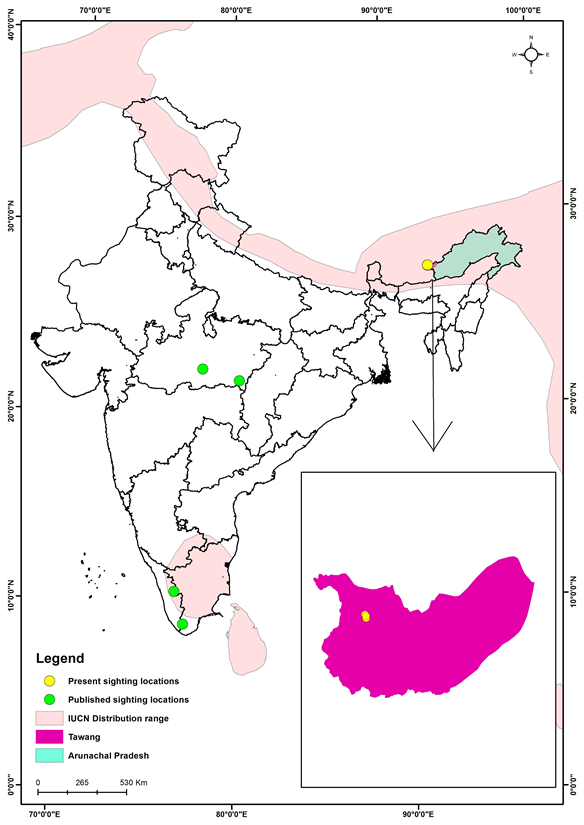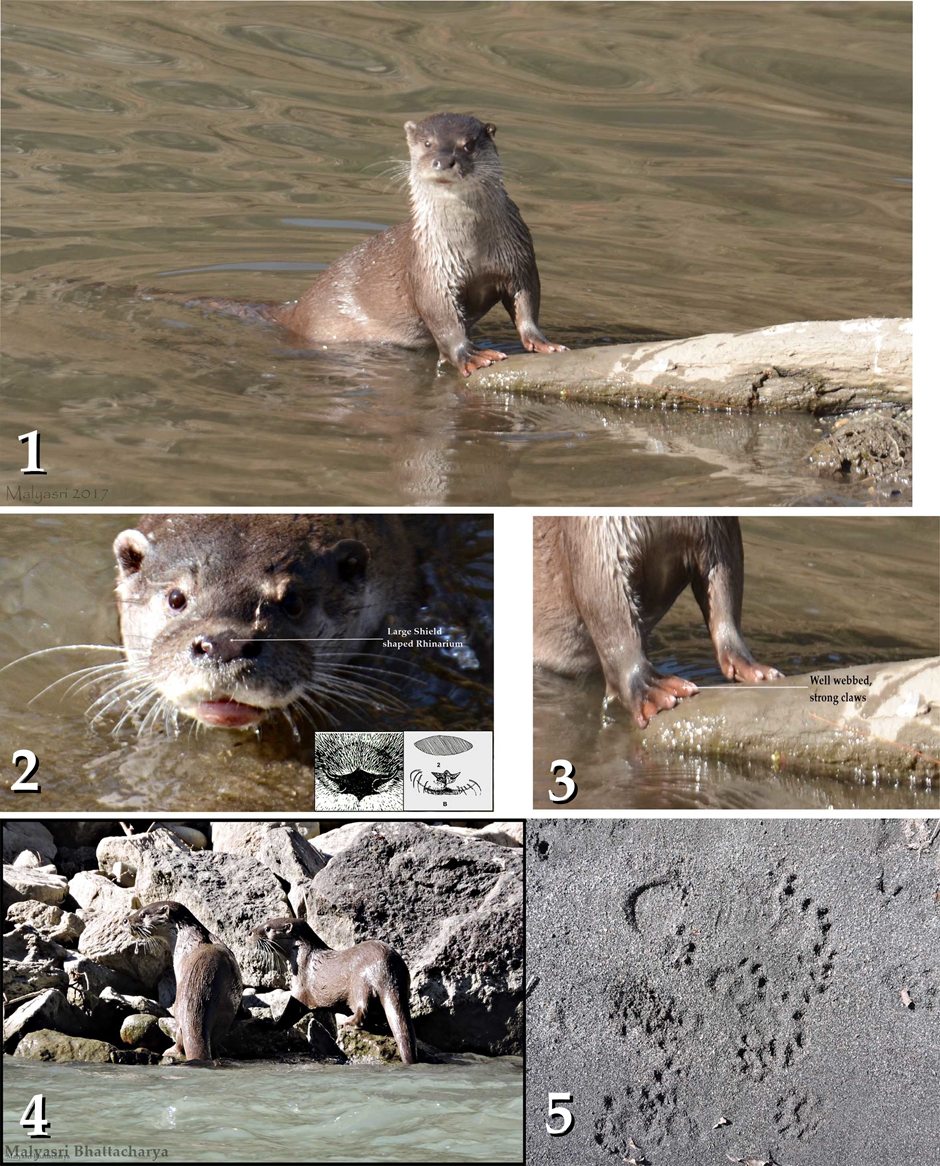IUCN/SSC Otter Specialist Group Bulletin

©IUCN/SCC Otter Specialist Group
Volume 36 Issue 2 (April 2019)
Citation: Bhattacharya, M, Watham, T and Gopi, GV (2019). Photographic Records of Eurasian Otter (Lutra lutra Linnaeus, 1758) from Nyamjang Chu River, Arunachal Pradesh, India. IUCN Otter Spec. Group Bull. 36 (2): 103 - 109
Photographic Records of Eurasian Otter (Lutra lutra Linnaeus, 1758) from Nyamjang Chu River, Arunachal Pradesh, India
Malyasri Bhattacharya1, Taibangba Watham2 and G.V. Gopi1,3
Department of Endangered Species Management, Wildlife Institute of India,
P.O. Box # Chandrabani, Dehradun, Utarakhand 248001.
Indian Institute of Remote Sensing,4, Kalidas Rd, Hathibarkala, Dehradun, Uttarakhand 248001
E-mail: gopigv@wii.gov.in
Received 15th May 2019, accepted 5th June 2019
Abstract: A few individuals of Eurasian otters were sighted in the Nyamjang Chu river, Tawang district, Arunachal Pradesh during three months fieldwork between December 2017 and February 2018. The individuals were filmed and photographed swimming in the Nymjang Chu river. Previous records have listed the occurrence of smooth-coated otter and Asian small-clawed otter from Arunachal Pradesh. The present sighting is the first photographic evidence from the North-East Indian state of Arunachal Pradesh. The record shows the importance of the habitat of Nyamjang Chu River valley currently facing a threat of submergence from an upcoming hydroelectric power project.
Keywords: Eurasian Otter, Lutra lutra, Zemithang Valley, Tawang District, Nyamjang Chu River
INTRODUCTION
The Eurasian otter Lutra lutra (Linnaeus, 1758) has the widest distribution among the old world mammals (Corbet, 1966). It ranges from Western Europe to Eastern Asia as well as Africa, in Asia, it inhabits almost all Himalayan river systems up to far south in Sumatra, Indonesia (Corbet and Hill, 1992). There are seven subspecies of the Eurasian otter (Pocock 1941) including L. l. nair, (Cuvier, 1823) in southern India, Sri Lanka, Nepal, Bhutan and Myanmar , L. l. kutab (Schinz, 1844) in northern India – Kashmir, L. l. aurobrunneus (Hodgson, 1839) in Garhwal Himalayas in north India and higher altitudes in Nepal, L. l. monticolus (Hodgson, 1839) in India from Himachal Pradesh, Sikkim, and Assam, L. l. barang (Cuvier, 1823) in southeast Asia (Thailand, Indonesia, and Malaysia), L. l. chinensis (Gray, 1837) in southern China and Taiwan and L. l. lutra (Linnaeus, 1758) in Europe and northern Africa. The Eurasian otter has been recently reported from the forests of Madhya Pradesh including Balaghat forest circle (Jena et al, 2016) and Satpura tiger reserve (Joshi et al 2016). It has also been observed in Periyar tiger reserve in Kerala and Kalakkad Mundanthurai Tiger Reserve in Tamil Nadu (Raha and Hussain 2016) (Fig. 1). However, in spite of its shown range as per IUCN, little published information is available on the occurrence of Eurasian otter from North-eastern states of India. The lack of accessibility in many parts of the Himalayan ranges in Northeast India has resulted in distribution gaps in published records.

So far, there are no records of this species from Arunachal Pradesh. The present sighting from Tawang, Arunachal Pradesh is, therefore, the first photographic record of the species from North-east India.
During 2017-2018, while undertaking fieldwork on the project “Assessment of habitat use by Black-necked Crane and e-flows of Nyamjang Chu hydroelectric project, Tawang”, we encountered direct sightings as well as indirect evidence (footprints) of Eurasian otter in different locations along the Nyamjang Chu River. There were direct sightings both at upstream locations and the downstream locations of the proposed dam in the Nyamjang Chu River.
On December 14, 2017, the first sighting of a Eurasian otter was confirmed in the Nyamjang Chu River, Zemithang (27°43’16.39”N, 91°.43’32.07”E). It was photographed and filmed using handheld camera Nikon D5100 with 70-300VR. The well-webbed feet with strong claws with webs between the toes extending to the last bone of each digit (Pocock 1941) and the shield-shaped ‘W’ like rhinarium (Foster-Turley 1992) confirmed its identification as an Eurasian otter (Figure 2,1-4). It was continuously followed from the downstream to the upstream of the river for an hour and was observed feeding on medium sized fishes. The animal allowed proximity of 1 m and continuously searched for food from one river bank to another bank. Eventually, it dived from a nearby sand mining area and disappeared in the waters of the river. Subsequently, on January 9th, two otters were seen together in the Nyamjang Chu River. They played and groomed each other for about 20 minutes and were seen hunting fishes, and subsequently moved towards the upstream.

Furthermore, there were several sightings of the Eurasian otter during December 2017 to February 2018 across that particular river stretch. Photographic records of its footprints were collected from along the river bank (Figure 2, 5). Discussion with locals revealed they frequently see the otters for quite sometime in this stretch of the river. Three fish species, viz. Mystus vittatus, Amblyceps mangois, and Exostoma berdmorei have been recorded at the barrage site (Barik et al. 2015) which the Otterperhaps preys on.
Our study showed the terrain is mostly rocky along with dispersed vegetation on each side of the river. The depth of the River in this part varies from 0.43-1.5 m. Some of the riparian vegetation types are Hippophae rhamnoides, Artemesia sp., Pteridium aquilinum, Elaeagnus sp. (Table 1).
In the Indian sub-continent, the Eurasian otter usually prefer to stay in the high altitude Himalayan mountains and cold streams with attitude as high as 3660 m (Prater 1971). During summer they move towards high elevation probably to harmonize with the upward migration of the fishes for spawning. In winters they again come down to lower altitudes (Prater 1971). Though Eurasian otter inhabits a variety of habitats such as lakes, rivers, streams, rivers, swamps, coastal area and estuaries, their distribution in India was recorded from lower Himalayas, Western Ghats and also from the parts of North-east India. In India, otter research is restricted to limited studies on Smooth-coated (Lutra perspicillata) and Small-clawed (Aonyx cinerea) otters (Sanyal 1991, Hussain 1999) and to Southern India (Nagulu 1996, Raha and Hussain 2016). Some of the sightings suggested that the otters are confined within the protected areas, and only a few occur outside the protected areas. (Hussain 1999). Very little information is available on the status of Eurasian otters found in India.
The otters found in India are all protected under the Indian Wild Life (Protection) Act, 1972, which forbids both trapping and killing. The Eurasian Otter is listed in the Schedule II of the Indian Wildlife (Protection) Act, 1972. The continuous decrease in the otter populations of India is mainly due to habitat degradation, continuous deforestation, construction of hydroelectric power projects, overexploitation, poaching, and trading, as well as human-induced contamination of the water bodies, poses an extreme threat to the otters in India. As per our study, the proposed construction of the dam on Nyamjang Chu River will submerge the area, thereby directly affecting the Eurasian otter habitat.
During our study, we have evidenced continuous sand mining in the Nyamjang Chu River river valley and deforestation, which are altering the habitat by affecting the natural riparian vegetation otherwise essential for the otter. The disposal of varieties of waste (including plastic bags) left by the workers creates absolute waste pollution in the riverbed of otter’s habitat. At the same time due to the road accessibility in the riverbed for sand mining practices, constant vehicle traffic affects the natural habitat of the valley. Zemithang is situated 11km away from China border, a large number of plastic bags coming downstream the river from China creates plastic pollution in the Nyamjang Chu River bed which is a severe threat to the river-dependent Eurasian otter.
During our survey, it was observed that the people of Zemithang valley, Monpa tribe in general, have strong compassion toward wildlife. Hunting or fishing are strictly prohibited in Zemithang area mostly by the locals themselves. Local communities serve as a critical element for the conservation of wildlife in the region. But only the exemption of hunting or fishing has not decreased the threat for the otter in the Nyamjang Chu valley.
The Eurasian otter is categorized as Near Threatened by the IUCN Red List of Threatened Species and it is listed in ‘Appendix I’ of CITES due to its continuous population decline which is at a rate no longer exceeding 30% over the past three generations (Pacifici et al. 2013). The report confirms the distribution of Eurasian otter in the extreme west of Arunachal Pradesh outside the protected area. However, it falls under two adjoining Community Conserved Areas Pangchen Lumpo Muchat Community Conserved Area and Pangchen Lakhar Community Conserved Area, in two sides of the valley where it can be given importance for conservation. Continuous monitoring of this species is required to know the range of the species in the area in association with the local communities. Effective planning for decreasing the threats affecting its habitat is necessary to conserve the species. Association of local communities along with the help of the forest department by organizing awareness programmes and campaigns may create awareness about the conservation of Eurasian otter.
Acknowledgements - We acknowledge help and support received from Dr. V.B. Mathur, Director, Wildlife Institute of India, Dehra Dun and Dr. G. S. Rawat, Scientist-G & Dean, Wildlife Institute of India, Dehra Dun. We are particularly thankful to Dr. S.A. Hussain, Scientist G, Wildlife Institute of India for his support and comments while writing the paper. We are grateful to the Ministry of Environment, Forest and Climate Change for funding the study. We are also thankful to the Chief Wildlife Warden, Arunachal Pradesh, Conservator of Forest, Arunachal Pradesh, Divisional Forest Officer, Tawang, Dr.Abdul Qayam and RFO Tawang, Mr. T.haniya for facilitating and extending their support to us. We want to extend our gratitude to all the people of Zemithang, Tawang District especially Mr. Degin Dorjee, Head Master T-Gompa Govt. School & consultant WWF, who helped us during the surveys. We are grateful to our field assistant – Sri. Pemba Tsering Romo for his extensive support in the field. We want to acknowledge the Army and ITBP officers especially ITBP, ACP Mr. Asutosh Kumar Sanyal, Col Naveen Benzit, Maj. Anshid for extending their support during our study. We are incredibly thankful to Mr. Kamal Medhi, Mr. Rajarshi Chakraborty, Ms. Jaya Upadhaya from WWF for their assistance and support to carry our survey in the field as well as a help for the local assistance in Tawang district. We want to acknowledge Sujan Chatterjee from East India birding for his comments on the identification of the Eurasian otter..
REFERENCES
Acharjyo, L.N., Mishra. C.G. (1983). A note on the longevity of two species of Indian otters in captivity. J. Bombay Nat. Hist. Soc. 80(3): 636.
Barik S.K. (2015) Perspective Plan for Development of Tawang River Basin. Final report, North-Eastern Hill University, Shillong. 912 pp.
Chitampalli, M.B. (1979). Miscellaneous notes, On the occurrence of the common otter in Maharashtra (Itiadoh Lake-Bhandara District) with some notes on its habits.J. Bombay Nat. Hist. Soc. 76: 151-152.
Corbet, G.H. (1966). The Terrestrial Mammals of Western Europe. Foulis, London. 200 pp.
Corbet, G.H., Hill, J.E. (1992). The mammals of the Indomalayan Region. A systematic review. Oxford University Press, Oxford. 488 pp.
Desai, J.H. (1974). Observations on the breeding habits of the Indian smooth otter: Lutrogale perspicillata: in captivity. International Zoo Yearbook 14 (1): 123-124.
Foster-Turley, P. (1992). Conservation ecology of sympatric Asian otters Aonyx cinerea and Lutra perspicillata. Ph.D. Dissertation, University of Florida. USA, 172 pp.
Hinton, M.A.C., Fry,T.B. (1923).BNHS mammal survey of India, Burma and Ceylon. Report No.37, Nepal. J. Bombay Nat.Hist.Soc. 29: 399-428.
Hussain, S.A (1999) Status of otter conservation in India. Envis bulletin:Wildlife and protected Areas, Wildlife Institute of India 2(2): 92-97.
Jena, J., Bhargava, D.,Borah, J., Dey, S. (2016). On the occurrence of the Eurasian otter (Lutra lutra l.) In the forest of Balaghat, Madhya Pradesh, India. IUCN/SCC Otter Specialist Group Bulletin. 33: 59-63.
Joshi, A.S, Tumsare, V.M, Nagar, A.K, Mishra, A.K, Pariwakam, M.P. (2016). Photographic Records of Eurasian Otter Lutra lutra from the Central Indian Landscape. IUCN Otter Spec. Group Bull. 33(2): 73 - 78
Macdonald, S.M., Mason C.F., Shalmon. B. (1986): A survey for otters in Israel. Oryx 20 (4): 233-236.
Medhi.K, Chakraborty, R. and Upadhyaya, J. (2014). Photographic record of Smooth-coated otter (Lutrogale perspicillata Geoffroy 1826) in Nyamjang Chu Valley, Arunachal Pradesh, India. IUCN Otter Spec. Group Bull. 31(2): 75 - 79
Nagulu, V, Vasudeva Rao, V., Srinivasulu, C. and Ramana Rao, J.V. (1997). A Preliminary Survey of Otters on the Malabar Coast and the adjoining Hill Reservoirs and Streams IUCN Otter Spec. Group Bull. 14 (1): 30 - 34
Naniwadekar, R., Shukla, U, Viswanathan. A and Datta.A (2013). Records of small carnivores from in and around Namdapha Tiger Reserve, Arunachal Pradesh, India. Small Carnivore Conservation. 49: 1-8.
Pacifici, M., L. Santini, M. Di Marco, D. Baisero, L. Francucci, G. Grottolo Marasini, P. Visconti, C. Rondinini. ( 2013). Generation length for mammals. Nature Conservation 5: 87 - 94.
Pocock, R.I. (1939).The fauna of British India including Ceylon and Burma. Mammalia, 2nd edn, I. Taylor & Francis, London, U.K
Prater, S.H. (1980). The Book of Indian Animals. Bombay Natural History Society, India. 324 pp.
Raha, A., Hussain, S.A. (2016). Factors affecting habitat selection by three sympatric otter species in the southern Western Ghats, India. Acta Ecologica Sinica. 36: 45-49.
Sanyal, P. (1988). Status of otters in West Bengal. IUCN Asian Otter Spec. Group Newsletter, 1, 17.
Tate, G.H.H. (1947). Mammals of eastern Asia. Macmillan Company, New York. 366 pp.
Wayre, P. (1978). The status of otters in Malaysia, Sri Lanka and Italy. Otters (N. Duplaix, ed.). Proceedings of the First Working Meeting of the Otter Specialist Group, International Union for the Conservation of Nature, Gland, Switzerland.
Résumé : Enregistrements Photographiques de la Loutre Eurasienne (Lutra lutra Linnaeus, 1758) sur la Rivière Nyamjang Chu, située dans l’État d’Arunachal Pradesh, En Inde
Durant trois mois de travaux de terrain entre décembre 2017 et février 2018, quelques loutres eurasiennes ont été aperçues sur la rivière Nyamjang Chu dans le district du Tawang de l’état d’Arunachal Pradesh,. Les individus, nageant dans la rivière Nymjang Chu, ont été filmés et photographiés. Des enregistrements antérieurs mentionnent la présence de loutre à pelage lisse et de loutre cendrée dans l’état d’Arunachal Pradesh. Cette observation récente de loutre eurasienne est la première preuve photographique de la présence de l’espèce dans l'état d'Arunachal Pradesh, au nord-est de l'Inde. L’enregistrement montre l’importance de ce type d’habitat (vallée de la rivière Nyamjang Chu) actuellement menacé d’immersion par un projet de centrale hydroélectrique..
Revenez au dessus
Resumen: Registros Fotográficos de la Nutria Eurasiática (Lutra lutra Linnaeus, 1758) del Río Nyamjankg Chu, Arunachal Pradesh, India
Durante tres meses de trabajo de terreno entre Diciembre de 2017 y Febrero de 2018, avistamos unos pocos individuos de nutria eurasiática en el Río Nyamjang Chu, distrito de Tawang, Arunachal Pradesh. Los individuos fueron filmados y fotografiados mientras nadaban en el Río Nyamjang Chu. Registros anteriores han detectado la ocurrencia de nutria lisa y nutria de uñas pequeñas asíatica, en Arunachal Pradesh. Los avistamientos aquí reportados son la primer evidencia fotográfica del estado de Arunachal Pradesh, India. El registro muestra la importancia del hábitat del valle del Río Nyamjang Chu, que actualmente enfrenta una amenaza de ser sumergido por un proyecto de energía hidroeléctrica.
Vuelva a la tapa


